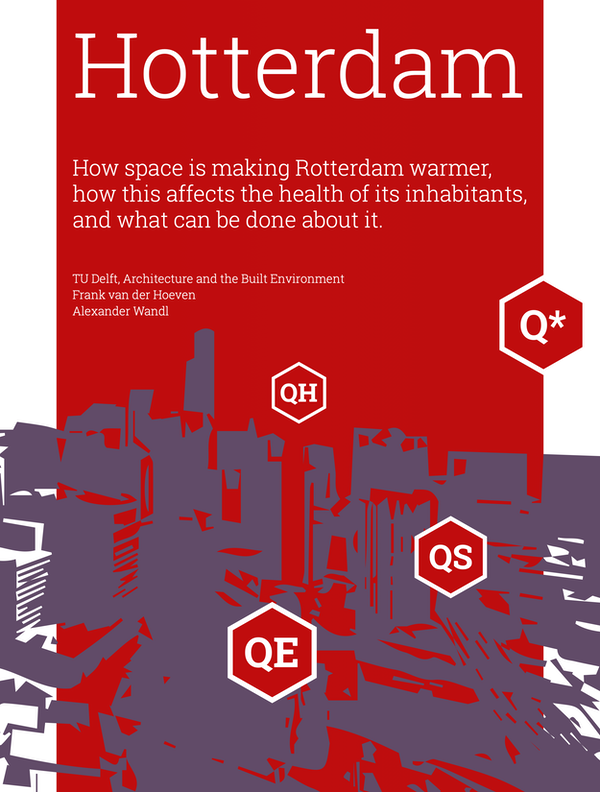Hotterdam
How space is making Rotterdam warmer, how this affects the health of its inhabitants, and what can be done about it
Downloads

Synopsis
Heat waves will occur in Rotterdam with greater frequency in the future. Those affected most will be the elderly – a group that is growing in size. In the light of the Paris heat wave of August 2003 and the one in Rotterdam in July 2006, mortality rates among the elderly in particular are likely to rise in the summer.
METHOD
The aim of the Hotterdam research project was to gain a better understanding of urban heat. The heat was measured and the surface energy balance modelled from that perspective. Social and physical features of the city we identified in detail with the help of satellite images, GIS and 3D models. We determined the links between urban heat/surface energy balance and the social/physical features of Rotterdam by multivariable regression analysis. The crucial elements of the heat problem were then clustered and illustrated on a social and a physical heat map.
RESULTS
The research project produced two heat maps, an atlas of underlying data and a set of adaptation measures which, when combined, will make the city of Rotterdam and its inhabitants more aware and less vulnerable to heat wave-related health effects.
CONCLUSION
In different ways, the pre-war districts of the city (North, South, and West) are warmer and more vulnerable to urban heat than are other areas of Rotterdam. The temperature readings that we carried out confirm these findings as far as outdoor temperatures are concerned. Indoor temperatures vary widely. Homes seem to have their particular dynamics, in which the house’s age plays a role. The above-average mortality of those aged 75 and over during the July 2006 heat wave in Rotterdam can be explained by a) the concentration of people in this age group, b) the age of the homes they live in, and c) the sum of sensible heat and ground heat flux. A diverse mix of impervious surfaces, surface water, foliage, building envelopes and shade make one area or district warmer than another. Adaptation measures are in the hands of residents, homeowners and the local council alike, and relate to changing behaviour, physical measures for homes, and urban design respectively.
References
Barsi, J. A., Schott, J. R., Palluconi, F. D., & Hook, S. J. (2005). Validation of a web-based atmospheric correction tool for single thermal band instruments. In J. J. Butler (ed.), Proc. SPIE 5882, Earth Observing Systems X, 58820E. Bellingham, WA: SPIE. doi: 10.1117/12.619990
Daniele, V. (2010). Urban planning and design for local climate mitigation. A methodology based on remote sensing and GIS. Paper presented at the 46th ISOCARP Congress 2010, Nairobi, Kenya. Retrieved from http://www.isocarp.net/Data/case_studies/1815.pdf
Dousset, B., Gourmelon, F., Laaidi, K., Zeghnoun, A., Giraudet, E., Bretin, P., Maurid, E. & Vandentorren, S. (2011). Satellite monitoring of summer heat waves in the Paris metropolitan area. International Journal of Climatology, 31(2), 313-323. doi:10.1002/joc.2222
Dousset, B. & Gourmelon, F. (2003) Surface temperatures of the Paris Basin during summertime, Using satellite remote sensing data. In Proceedings of the 5th International Conference on Urban Climate, Lodz, Poland, September 2003. Retrieved from http://nargeo.geo.uni.lodz.pl/~icuc5/text/O_27A_2.pdf
Greater London Authority. (2006). London’s Urban Heat Island: A Summary for Decision Makers. Retrieved from http://legacy.london.gov.uk/mayor/environment/climate-change/docs/UHI_summary_report.pdf
Harman, I. N. (2003). The energy balance of urban areas. (Doctoral dissertation, The University of Reading, Reading, United Kingdom). Retrieved from http://www.met.rdg.ac.uk/phdtheses/The%20energy%20balance%20of%20urban%20areas.pdf
Mavrogianni A., Davies M., Batty M., Belcher S.E., Bohnenstengel S.I., Carruthers D., Chalabi Z., (...), Ye Z. (2011). The comfort, energy and health implications of London’s urban heat island. Building Services Engineering Research and Technology, 32 (1) , pp. 35-52. doi: 10.1177/0143624410394530
Mavrogianni, A., Davies, M., Chalabi, Z., Wilkinson, P., Kolokotroni, M., & Milner, J. (2009). Space heating demand and heatwave vulnerability: London domestic stock. Building Research & Information, 37(5-6), 583-597. doi:10.1080/09613210903162597
Robine, J. M., Cheung, S. L., Le Roy, S., Van Oyen, H., & Herrmann, F. R. (2007). Report on excess mortality in Europe during summer 2003 (EU Community Action Programme for Public Health, Grant Agreement 2005114). Retreived from http://ec.europa.eu/health/ph_projects/2005/action1/docs/action1_2005_a2_15_en.pdf
Vandentorren, S., Bretin, P. , Zeghnoun, A., Mandereau-Bruno, L., Croisier, A., Cochet, C., … Ledrans, M. (2006). August 2003 Heat Wave in France: Risk Factors for Death of Elderly People Living at Home. European Journal of Public Health, 16(6), 583–591. doi:10.1093/eurpub/ckl063
van der Hoeven, F., & Wandl, A. (2013). Amsterwarm: Gebiedstypologie warmte-eiland Amsterdam. Delft, Nederland: TU Delft, Faculty of Architecture.
van der Hoeven, F., & Wandl, A. (2015). Amsterwarm: Mapping the landuse, health and energy-efficiency implications of the Amsterdam urban heat island. Building Services Engineering Research and Technology, 36(1), 67-88. doi:10.1177/0143624414541451
van der Hoeven, F., & Wandl, A. (2015). Hotterdam: Hoe ruimte Rotterdam warmer maakt, hoe dat van invloed is op de gezondheid van de inwoners, en wat er aan te doen is. Delft, Nederland: TU Delft Bouwkunde. doi:10.7480//bkbooks/hotterdam/nl
Yale Center for Earth Observation. (2010). Converting Landsat TM and ETM+ thermal bands to temperature. Retrieved from http://www.yale.edu/ceo/Documentation/DN_to_Kelvin.pdf
Zaksek, K., Ostir, K., & Kokalj, Z. (2011). Sky-View Factor as a Relief Visualization Technique. Remote Sensing, 3(2), 398-415.





